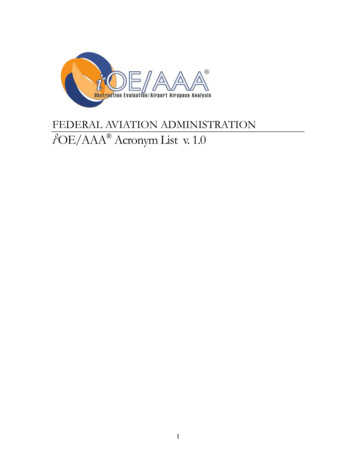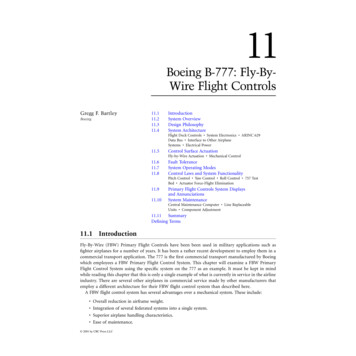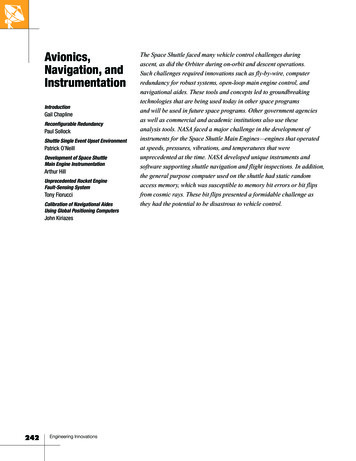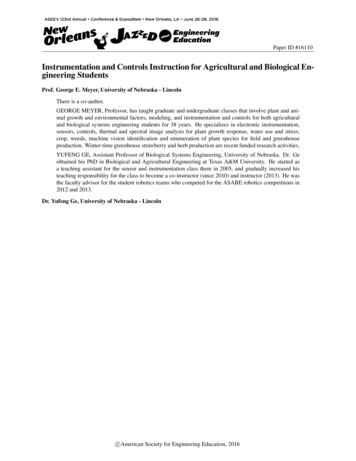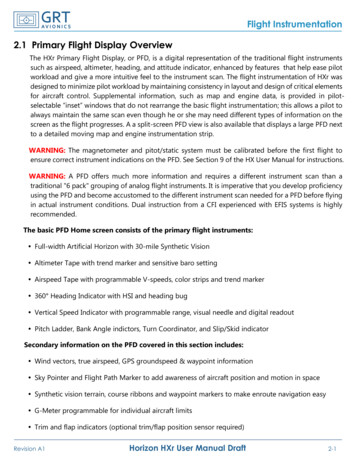
Transcription
Flight Instrumentation2.1 Primary Flight Display OverviewThe HXr Primary Flight Display, or PFD, is a digital representation of the traditional flight instrumentssuch as airspeed, altimeter, heading, and attitude indicator, enhanced by features that help ease pilotworkload and give a more intuitive feel to the instrument scan. The flight instrumentation of HXr wasdesigned to minimize pilot workload by maintaining consistency in layout and design of critical elementsfor aircraft control. Supplemental information, such as map and engine data, is provided in pilotselectable “inset” windows that do not rearrange the basic flight instrumentation; this allows a pilot toalways maintain the same scan even though he or she may need different types of information on thescreen as the flight progresses. A a split-screen PFD view is also available that displays a large PFD nextto a detailed moving map and engine instrumentation strip.WARNING: The magnetometer and pitot/static system must be calibrated before the first flight toensure correct instrument indications on the PFD. See Section 9 of the HX User Manual for instructions.WARNING: A PFD offers much more information and requires a different instrument scan than atraditional "6 pack" grouping of analog flight instruments. It is imperative that you develop proficiencyusing the PFD and become accustomed to the different instrument scan needed for a PFD before flyingin actual instrument conditions. Dual instruction from a CFI experienced with EFIS systems is highlyrecommended.The basic PFD Home screen consists of the primary flight instruments:Ÿ Full-width Artificial Horizon with 30-mile Synthetic VisionŸ Altimeter Tape with trend marker and sensitive baro settingŸ Airspeed Tape with programmable V-speeds, color strips and trend markerŸ 360 Heading Indicator with HSI and heading bugŸ Vertical Speed Indicator with programmable range, visual needle and digital readoutŸ Pitch Ladder, Bank Angle indictors, Turn Coordinator, and Slip/Skid indicatorSecondary information on the PFD covered in this section includes:Ÿ Wind vectors, true airspeed, GPS groundspeed & waypoint informationŸ Sky Pointer and Flight Path Marker to add awareness of aircraft position and motion in spaceŸ Synthetic vision terrain, course ribbons and waypoint markers to make enroute navigation easyŸ G-Meter programmable for individual aircraft limitsŸ Trim and flap indicators (optional trim/flap position sensor required)Revision A1Horizon HXr User Manual Draft2-1
Flight orSkyPointerAttitudeIndicatorTurn RateIndicatorFlight PathMarkerVerticalSpeedIndicatorHeight AGLAltimeterAltimeterSettingWindSlip/Skid “Brick”– Slides under Sky Pointer triangle to represent coordination. Replaces traditional skid-ball;“Step on the brick.”Sky Pointer– Always points toward sky, perpendicular to Earth.Turn Rate Indicator– Place Sky Pointer on green triangle for standard rate turn.Vertical Speed Indicator- White band is visual, digital block on bottom is actual vertical speed.Altimeter– Tape with color-coded bands for terrain awareness.Wind Vector– Displays Headwind/Tailwind and L/R crosswind components.Altimeter Setting– Traditional barometric pressure setting.Height AGL- Derived from GPS altitude and terrain database. Visible on Synthetic Approach only.Flight Path Marker– Airplane’s path through space in relation to the ground.Attitude Indicator– Traditional attitude indicator markings; uses entire screen as a horizon.Airspeed Indicator– Airspeed tape with configurable V-speeds, colored bands, and trend indicator2-2Horizon HXr User Manual DraftRevision A1
Flight Instrumentation2.2 Attitude Indicator/Artificial HorizonThe Artificial Horizon is just that, a pictorial representation of the earth. The blue portion represents thesky; the green or brown portion represents the ground. The HXr displays a computer generatedrepresentation of the “view out the window” using GPS-based technology known as synthetic visionto enhance the artificial horizon and make it more realistic. By adding details such as mountain peaks,runways, and obstacles to the pilot’s instrument scan field of view, the system adds intuitive situationalawareness even in low visibility and instrument conditions. Other instruments add motion sensing,trend vectors and environmental information to the scan as well, providing an intuitive feel for the pilot.The total picture offered by the artificial horizon consists of several components working together.Attitude Reference IndexThe Attitude Reference Index is always the in the sameposition relative to the aircraft. The horizon line, pitchladder and sky pointer move in relation to it, providingthe indications of pitch, roll, and “which way is UP.”The traditional attitude “bars” or “wings” can be replacedby a “nose” indicator (shown at right). This small indicator concisely displays the noseposition of the aircraft relative to the horizon.To select Nose or Bars (wings):1. Access Set Menu Primary Flight Display Attitude Reference Index.2. Select NOSE or BARS.NOTE: When ILS CDI crosshairs are displayed on the PFD, they replace theAttitude Reference Index. The crosshairs are always in the same position asthe Attitude Reference Index, so they provide an effective replacement.Displaying both would unnecessarily clutter the screen.Pitch Ladder OffsetThe Pitch Ladder is a portion of the artificial horizon that depicts the pitchangle of the aircraft in relation to the horizon. It consists of horizontal linesabove and below the neutral “zero-pitch” line, which is a thin white linestretched across the entire screen. Most of the ladder rungs are in 5-degreeincrements. Small horizontal lines below the zero-pitch line are in 1-degreeincrements for precise pitch control during landing approach. In thescreenshot above right, the pitch angle of the aircraft is about 1 degreenose-low, as shown by the Attitude Reference Index (bars) crossing the firstrung below the zero-pitch line. In the screenshot below it, note the whitecircle that marks the 90-degree pitch rung. This is visible during a loop orhammerhead.Revision A1Horizon HXr User Manual Draft2-3
Flight InstrumentationAdjusting Pitch Ladder OffsetDuring straight and level unaccelerated flight at the normal cruise power setting, the pitch laddershould be set so that the Attitude Reference Index is aligned with the zero-pitch line. The object is toset the pitch ladder for the easiest possible instrument scan during cruise.1. Press MORE Set Menu Primary Flight Display.2. Scroll to Pitch Ladder Offset. Adjustments are made in positive or negative 1-degree increments;a positive setting will move the Attitude Reference Index up, and a negative setting will moveit down.3. Adjust it in small increments until the Attitude Reference Index and the zero-pitch line arealigned during level normal cruise flight.be used to compensate for the tail-down attitude of a taildraggerNOTE: Pitch Ladder Offset shouldon the ground. When you are on the ground in a taildragger, the view out the virtual EFIS windowshould look toward the sky, just as it looks out the windshield. Pitch ladder offset is ONLY for calibratingstraight-and-level flight.It should also never be used to adjust the attitude indication for varying airspeeds or other flightconditions. Once it’s set for your particular airframe/engine/propeller combo, the Pitch Ladder Offsetshould not normally be moved. Adjusting this for varying flight conditions can be dangerous whenthose conditions change again, potentially leading to spacial disorientation in instrument conditions.Paying attention to a consistently-placed pitch ladder indication will result in greater understandingof the pitch changes that occur with changing airspeeds, power settings and cargo loading.Sky Pointer & Slip/Skid IndicatorThe Sky Pointer is the white triangle in the middle of the bank indicatorhash marks. This simply points UP at all times. If you roll inverted, it willpoint at the sky and thus appear as if it’s pointed at your floorboards. Thisis displayed as an aid for unusual attitude recovery and also serves as thebank angle pointer.The small rectangular bar that slides under the Sky Pointer is the Slip/SkidIndicator; thus, the modern instructor’s command for coordinated turnshas become “Step on the Brick!” At the request of some of our aerobaticHXr pilots, the traditional ball-type slip/skid indicator is now available asa choice on the HXr under the Set Menu Primary Flight Display Slipindicator setting. When “ball” is selected, the bar disappears and theelectronic ball is prominently displayed above the heading indicator.2-4Horizon HXr User Manual DraftRevision A1
Flight InstrumentationFlight Path MarkerThe flight path marker shows where the aircraft will go if all conditions of motion andwind stay the same. Shown as a circle with three spikes, it is a projection of theaircraft’s flight path. It combines many data factors including attitude, airspeed, andwind vectors calculated from GPS ground track, ground speed, airspeed and magneticheading. The flight path marker will appear to float about the display as the aircraftpitches and rolls. This movement is most evident in strong crosswind or unusual attitudes. For example,during a properly-flown crabbed crosswind approach, the heading (nose) will point to the upwindside, but the flight path marker (center of mass) will be superimposed on the virtual runway becausethat is where the airplane is going at that particular instant in time.2.3 Turn CoordinatorThe turn coordinator is depicted at the top of the pitch ladder and below the heading window as a pairof inverted green triangles. The HXr calculates the angle of bank required to make a standard rate turnat the current airspeed. The turn coordinator triangles spread out or in as the airspeed increases ordecreases. To make a standard rate turn, align the sky pointer with the green triangle.The turn coordinator can be turned off to declutter the display. To turn it on or off:1. Press MORE Set Menu Primary Flight Display.2. Scroll to Turn Rate Indicator3. Select ON or OFF as appropriate.Revision A1Horizon HXr User Manual Draft2-5
Flight Instrumentation2.3 Airspeed TapeThe primary function of the airspeed tape is to display indicated airspeed and its associated color bands,all of which are fully programmable according to the aircraft design limitations. It also has severalsupplemental sources of information to provide the pilot with an intuitive sense of airspeed change, aswell as true airspeed and groundspeed.True AirspeedDigital AirspeedReadoutTrend ArrowSpeed/DistanceUnitsGroundspeedThe instantaneous airspeed readout is contained in the black box with large, bold numbers. The digitsappear to “roll by” smoothly as speed changes. The units of distance/speed are displayed below thedigital readout. True airspeed (TAS) is displayed in the upper left corner, while GPS groundspeed isdisplayed in the lower left corner, as shown below.Trend ArrowThe trend arrow points to the predicted speed of the aircraft in 5 seconds at the current rate of acceleration.V-Speed Reference MarkersThe airspeed tape also features three programmable V-speed referencemarkers that appear as magenta triangles with letters X, Y, & G; thesestand for for VX, VY and VG (best glide).2-6Horizon HXr User Manual DraftRevision A1
Flight InstrumentationColored Airspeed BandsThe colored band on the airspeed tape follows the standard airspeed color scheme. The digital airspeedvalue turns yellow or red when it is within the yellow or red ranges for additional emphasis.Red/Black(optional)Zero to VS (full-flap stall speed). Airspeed values too low to register on the EFIS willappear as a red dash (- -) in the digital readout window. Option: Red or clear.WhiteFull-flap stall speed (VS0) to flap extension upper airspeed limit (VFE)GreenStall speed (VS0) to maximum structural cruise speed (VNO)YellowMaximum structural cruise speed (VNO) to never-exceed speed (VNE)Red/BlackNever-exceed (VNE) and beyondCustomizing the Airspeed Tape For Your AircraftThe airspeed indicator settings are programmed in SET Menu General Setup Primary Flight Display.They should be programmed before the first flight according to the design limitations of the aircraft,and can be fine tuned during flight testing to match the individual aircraft’s flight characteristics.2.4 Altimeter TapeThe Altimeter Tape displays altitude above meansea level (MSL) in hundreds of feet or meters. Eventhousands are depicted by a solid marker, eithera circle, triangle or rectangle. Five-hundred footincrements are depicted by a hollow marker. Thebaro setting is displayed in the lower right corner.TerrainClearanceColorBandThe terrain clearance color band on the edge ofthe altimeter tape shows the Off-Route ObstacleClearance Altitude (OROCA) which provides 1000foot obstruction clearance in non-mountainousterrain areas and 2,000-foot obstruction clearance Altitude Bugin designated mountainous areas within the (set below theUnited States. An altitude below the OROCA is tape range)shown yellow, above the OROCA is shown green.Revision A1Horizon HXr User Manual DraftDigital MSLAltitudeAltimeterSetting(BARO)2-7
Flight InstrumentationTo adjust the barometric pressure setting on the altimeter:1. From any HOME screen, press the light blue BARO softkey.2. Turn the right knob to the current altimeter setting.Alternatively, press the 29.92 softkey for transitioninto the flight levels.3. Press the knob again to accept the new baro setting or CANCEL to abandon the changes.NOTE: The difference between the pitot/static altitude and GPS-derived altitude is displayed in thewindow behind the right knob while the BARO controls are active.Using the Altitude BugThe Altitude Bug has a window located above the altimeter tape and is marked on the altimeter tapeitself by a magenta rectangle with a notch. The altitude bug serves two functions:Ÿ The commanded altitude for the autopilot toclimb/descend to and hold.Altitude PreselectWindowŸ A reminder for a cruise altitude or any other altitude thepilot wishes to remember.To set the altitude bug from any HOME page:1. Turn the Right Knob to enter the desired altitude into theAltitude Preselect Window.2. Press the knob to set.Altitude BugMarker3. If an autopilot with vertical navigation capability is installed and engaged, the system will thendisplay a message to verify the speed or rate of the climb or descent desired to fly to the setaltitude. See Autopilot section of this manual for more information on coupled climbs & descents.Altitude Intercept Arc (Map Screen)The Altitude Intercept Arc appears as a variable green arc on the mapscreen. It is a visual depiction of the place the aircraft will be when itintercepts the altitude entered into the altitude preselect window. It iscalculated using the current rate of climb or descent and groundspeed.During a climb or descent, adjust the rate of altitude change to placethe arc over the place you want to be when you get to your selected altitude. This can be very usefulin a cruise descent toward your destination if you set the altitude bug to pattern altitude or your nextIFR altitude. It can also be useful for planning climbs near high terrain. The more stable the descentor climb, the more stable the arc will be. It shrinks as you get closer to the altitude intercept point.2-8Horizon HXr User Manual DraftRevision A1
Flight InstrumentationAltitude Deviation AlertsAn alert can be set to flash on the EFIS when the altitude specified in the Altitude Bug Window isexceeded by a certain amount. To set an Altitude Alert:1. Press MORE Set Menu Primary Flight Display2. Scroll to Altitude Alerting and turn it ON.3. Highlight Max Altitude Deviation. Set the altitude deviation alert threshold- typically 200 feet.2.5 Vertical Speed IndicatorThe vertical speed indicator (VSI) is along the left side of the altimeter. VSIThe tape is white and radiates upward or downward from the neutral digitalmark as the aircraft climbs and descends. It shows vertical speed in feet valueor meters per minute. The vertical speed is also presented digitally atthe bottom of the scale when descending and at the top of the scalewhen climbing. The VSI tape’s upper limit can be programmed to fit theVSI tapeclimb performance capability of the aircraft for a more precise visualrepresentation.To customize the VSI:1. Press MORE Set Menu Primary Flight Display2. Scroll to Max Indicator Vertical Speed. Choose the upper limit ofthe VSI scale most appropriate for the aircraft’s climb performance.The actual rate of climb will still be displayed numerically even if the visual indicator is maxed out.2.6 Heading IndicatorThe HXr magnetic heading indicator is presented in a Horizontal Situation Indicator (HSI) format on thePFD screen and an arc format on the Map screen. This section of the manual covers the basic headingfunctions of the HSI. Detailed information on how to use the bearing pointers and navigation functionsof the HSI are found in the Navigation section of this manual.Using the Heading IndicatorThe heading indicator gets its magnetic information from the magnetometer and is corrected withinternal calculations by the AHRS. After the magnetometer is calibrated, there is no need or provisionfor manually adjusting it- it is all done automatically during AHRS boot-up and alignment. This eliminatesin-flight precession and forgetting to set it before takeoff, common issues with vacuum gyro instruments.Revision A1Horizon HXr User Manual Draft2-9
Flight InstrumentationComponents of the HSI (Horizontal Situation Indicator)The HSI overlays GPS and VOR/LOC courses onto a heading indicator. It functions as a standard HSI.Vertical Compass Presentation- Presents all 360 with your aircraft in the center. Automatically setscorrect magnetic heading before flight using magnetometer information.Magnetic Heading- The present magnetic heading is displayed in large numbers at the top.Heading Bug- Small rectangle, either white or dark magenta, used as a reminder and to control thelateral autopilot in heading mode. Controlled by the Left Knob.Track Pointer- Small magenta diamond that points in the direction of the current ground track.Bearing Pointers- Independent of the course pointer and always point at their corresponding navsource. BRG 1 has a solid head and single tail/shaft. BRG 2 has a split head and double tail/shaft.Course Selection Needle- Represents active nav course. The center segment of the GPS or VOR/LOCcourse needle, or Course Deviation Bar, moves along a CDI scale when in range.To/From Indicator: Green triangle appears when tracking a VOR radial; TO points toward CourseSelection Pointer head; From points toward Course Selection Pointer tail.MagneticHeadingGPS Ground Track PointerHeading BugBearing PointerHead (BRG 1)Course SelectionNeedle HeadCourse DeviationBarTo/FromIndicatorCourse SelectionNeedle TailCourse DeviationIndicator (CDI)ScaleBearing PointerTail (BRG 1)2-10Horizon HXr User Manual DraftRevision A1
Flight InstrumentationArc and Tape Heading PresentationsWhile the 360 HSI presentation is straightforward, the heading tape and arc views have some uniquefeatures. The tape view is present on the PFD Split Screen view if the EGT/CHT graphs are shown. The160 arc or 360 non-HSI view can be shown on the map screen.The heading tape covers a 70 span and is presented above the engine strip on the Split PFD screen. Itdisplays four parameters with the following white or magenta symbols:Magnetic HeadingHGPS Ground TrackTBearing or course to current GPS waypointHeading BugOn both the Primary Flight Display and Moving Map Setup pages, there is a setting for Up Referenceon the very top of the page. This can be either Heading or Track. Most pilots prefer their PFD headingindicator to be Heading Up so they can accurately follow ATC vectors. Track Up is usually preferredfor the moving map screen. The parameter that is set as the Up Reference is stationary at the top orcenter of the heading presentation and labeled as shown below.PFD TapeHeading UPBearing to GPSwaypointHeadingGroundTrackHeadingBugMap ArcTrack UPThe bearing and track symbols fit inside each other so they create a nice visual effect when the aircraftis on course.The symbols are magenta when they are selected for navigation; for example, if the autopilot is inheading mode, the heading bug and heading triangle will be magenta, and the track and bearingsymbols will be white.Revision A1Horizon HXr User Manual Draft2-11
Flight InstrumentationIn the tape and arc views, if one of the symbols runs off the edge of the screen, it becomes hollow andstays on the side of the screen closest to it, as shown below.Using the Heading BugTo change the position of the heading bug from any HOMEscreen, turn the left knob. The digital position of the heading bugwill display in the window above the left knob, and the visual bugindicator rotates around (or slides across) the heading tape.To immediately set the heading bug to the present heading,simply push the left knob to “sync” it.For more information about using the heading bug with the autopilot, please refer to the Autopilotsection of this manual.WARNING: Moving the heading bug while the autopilot is engaged in Heading Mode will result in animmediate turn to the new heading specified by the bug!Split Screen PFD HSI PresentationOn the Split Screen PFD, pilots can choose between the straight heading tape with EGT/CHT graphsor the full HSI presentation on the Split Screen PFD by pressing SCREEN PFD Options EGT/CHT orHSI softkeys. This allows the most important information to be displayed in a minimum amount of space.2-12Horizon HXr User Manual DraftRevision A1
Flight Instrumentation2.7 Wind Vector & Crosswind ComponentThe wind vector is located to the right of the altimeter baro setting. It is calculated using GPS groundtrack, ground speed, and heading and true airspeed data provided by the AHRS.It consists of two main parts- a vector arrow with velocity and direction, and a headwind/crosswindcomponent. At its simplest, it is an arrow with a velocity number next to it. The wind blows from tail tohead. The velocity is given in the speed/distance units chosen for the EFIS system. In addition to thevector arrow, a magnetic compass direction can also be displayed.To turn on the wind vector:1. Press MORE Set Menu Primary Flight Display2. Scroll to Wind Indicator Mode. Choose OFF, Vector and DigitalSpeed (shown above), or Vector and Digital Speed/Direction (addsmagnetic wind direction to the above display, shown at right).Headwind/Crosswind ComponentThe headwind/crosswind component gives headwind (H) or tailwind (T)first and left (L) or right (R) crosswind second. To turn on head/crosswindcomponent:1. Press MORE Set Menu Primary FLight Display2. Scroll to Digital Head/Crosswind Display and turn it ON or OFF.NOTE: If insufficient data exists for calculation of winds, the wind information is not displayed. Accuratewinds require accurate magnetic heading and airspeed data, which are enhanced by performing propercalibration of magnetometer and pitot/static systems as detailed in the HXr Installation Manual (alsothe HX User Manual, Rev. C, Section 9).Revision A1Horizon HXr User Manual Draft2-13
Flight Instrumentation2.8 G-MeterThe G-meter measures the G-loading of the airplane based on forces measured by the accelerometersinside the AHRS. It is displayed to the right of the airspeed tape on the Primary Flight Display.G-Meter SettingsPress MORE Set Menu Primary Flight Display to access G-Meter settings.G-Meter Mode- Choose if or how to display it on the Primary Flight Display.G-Meter Maximum- Sets the maximum positive G-loading on the scaleG-Meter Minimum- Sets the minimum negative G-loading on the scaleG-Meter Caution Max-Positive G-load caution threshold-Turns yellow beyond this valueG-Meter Caution Min- Negative G-load caution threshold- Turns yellow beyond this valueAuto G-Meter High Threshold- Displays the G-meter on the PFD in “Auto” setting when thispositive-G value is exceededAuto G-Meter Low Threshold- Displays the G-meter on the PFD in “Auto” setting when thisnegative value is exceededTurning On the G-Meter1. Press MORE Set Menu Primary Flight Display.2. Scroll to the G-Meter options near the bottom of the screen. Select an option on the G-MeterMode setting:a. Off- Does not display. Note that even when the G-Meter Mode is set to “Off,” all G force datais recorded during data logging.b. On- Displays all the timec. On with Min/Max- Displays all the time with the minimum and maximum Gs experienced duringthe flightd. Auto- Comes on if a preset Auto G-Meter High or Low Threshold is exceeded. This allows it toreplace Trim Indicators temporarily until the G limits settle below the threshold. (See TrimIndicator notation.)2-14Horizon HXr User Manual DraftRevision A1
Flight InstrumentationSetting Up the G-MeterEnter the maximum (positive limit) and minimum (negative limit) of your aircraftin the G-Meter Minimum and Maximum settings. Set the Caution limits thesame way; the G meter turns red if the Max/Min limits are exceeded, and turnsyellow if the Caution limits are exceeded. Your aircraft designer may haveestablished caution levels, or you can choose your own.Using the G-Meter with Trim IndicatorsSpace on the PFD is limited, and the best place for the flap and pitch trim indicators happens to be thesame place the G meter resides. The G-Meter Mode “Auto” setting will automatically make the G meterappear in place of the trim indicator when the Auto G-Meter Max and Min Threshold limits are exceededin flight.G-Meter Data LoggingG-force data is recorded with all of the other AHRS data during a demo recording. For instructions onFeature of thehow to record a permanent record of your G readings, see theWeek on the GRT website for automatic recording of flight data.G-Meter LimitationsThe G-meter has the same limitations as the AHRS: /- 10 G of acceleration.2.9 Flap and Trim IndicatorsIf the aircraft is equipped with electronic flap and trim position sensors, they can be wired directly tothe HXr analogs and the indication programmed to appear on the screen, eliminating the need forexternal LED indicator lights. See HXr Installation Manual for information on wiring and setup.The indicators appear to the immediate lower right of the airspeedindicator, as shown below.To change the direction of the Pitch Trim indication (UP on top orDOWN on top):1. Press MORE Set Menu General Setup.2. Scroll to Elevator Trim Orientation and choose Down trim(D) at the top or UP trim (U) at the top.Revision A1Horizon HXr User Manual Draft2-15
Flight Instrumentation2.10 Angle of Attack Indicator (AOA)Angle-of-Attack is calculated by the EFIS bycombining a variety of sensor data. It may be usedto drive two different indicators on the PFD screen.Angle-of-attack is not of much value for mostphases of flight, but is useful for stall warning, andto a limited extent, as a means of establishing anapproach speed that accounts for the currentweight of the airplane.WARNING: The AOA must be activated in thePrimary Flight Display set menu and calibratedbefore use. See HX User Guide, Section 9 for moreinformation.WARNING: The use of this indication is purely at the judgment of the pilot. The accuracy of this AOAindexer, and its stall warning, is affected by EFIS sensor errors and the accuracy of the calibrationprocedure. The EFIS calculation of angle-of-attack, and the approach AOA indexer should not be usedas the only stall warning instrument. Some indication lag and error will occur when flying through areasof rising and falling air; Do not rely on the indexer in turbulent conditions.Approach AOA IndexerThis indicator appears just to the right of the airspeed tape, andshows the angle-of-attack relative to the optimal for approach.When the angle-of-attack too low (the airplane is flying faster thanoptimal approach speed), yellow chevrons pointing up into ayellow circle prompt the pilot to increase back pressure to reducespeed, and similarly, red chevrons pointing down into a circleprompt the pilot to push forward to increase speed. When stall isimminent, the word "PUSH" appears above the AOA indexer. Theindexer will show a green circle, with no chevrons, when theangle-of-attack is in the optimal range for approach. The approachAOA indexer will not appear at low angles-of-attack.Barber-Pole Stall Speed IndicatorA vertical red/black bar is displayed on the bottom half of theairspeed tape. The top of this bar corresponds to the stall speedat the current "G" loading, and is based on the stall speed entrymade in the EFIS, and the normal acceleration "G's" sensed by theAHRS.2-16Horizon HXr User Manual DraftRevision A1
Flight InstrumentationPitch Limit IndicatorWhen enabled on the PFD settings page, the pitch limit indicator appears on the PFD screen when theangle-of-attack is less than 8 degrees from stall, and goes away when the angle of attack more than 9degrees from stall. It resembles a red pair of antlers and is shown in the screenshot below. The indicatormoves downward toward the nose or bars pitch indicator as the angle of attack increases. Stall willoccur approximately when this indicator is on the nose or bar pitch indicator. This indicator is limitedto 30 degrees pitch to prevent chasing a pitch limit that could temporarily be at a very high pitch angledue to high airplane speed.The pitch limit indicator was originally created to give pilots amaximum pitch angle reference when performing a windshearescape maneuver. While this may be of little use for the typicalexperimental aircraft pilot, it could be useful for assisting withterrain avoidance in a low airspeed situation. In that case, thepilot can use the pitch limit indicator as an approximatereference of a
aircraft's flight path. It combines many data factors including attitude, airspeed, and wind vectors calculated from GPS ground track, ground speed, airspeed and magnetic heading. The flight path marker will appear to float about the display as the aircraft pitches and rolls. This movement is most evident in strong crosswind or unusual attitudes.
